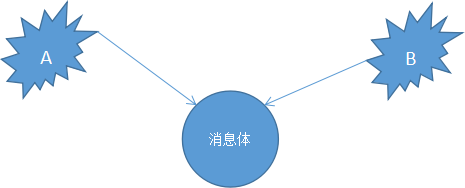一、事件的本质
举个例子你是个取向正常的青年男性,有个身材火辣,年轻貌美,腿长肤白的美女,冲你一笑,给你讲了一个ABCD羊吃草的故事。你有什么反应?
可能你关注点在于颜值,身材,故事,故事含义。后续事情?OK,这些都没毛病。和事件有什么关系呢?以上你关注的所有东西都可以概括为信息-事件。
她发出了一个信息,你做出了反应。 那么整个事件的运行机制就完成了。
简单的说就是 :一个对象发出消息,另外的对象做出响应。
如图:
那么再具体的详细的讲解不如Show Code :上代码:
//如果本篇幅过于难以理解那么,https://www.cnblogs.com/LiMin/p/10364867.html 这个是简单版本的可以帮助你先快速理解
namespace ConsoleApplication4
{
class Program
{
static void Main(string[] args)
{
PLMM plmm = new PLMM();//漂亮妹妹
DS ds = new DS();//屌丝
GFS gfs = new GFS();//高富帅
MsgEventArgs msg = new MsgEventArgs
{
MsgFrom = "美女",
MsgTo = "取向正常的男性",
MsgContent = "冲你笑,讲羊吃草故事。"
};
msg.Register(plmm, ds, gfs);//注册
plmm.SendMsg(msg);//发送
Console.ReadLine();
}
}
#region 收发事件消息接口
/// <summary>
/// 程序角度:事件的定义是:public delegate EventHandler<TEventArgs>(object sender, TEventArgs e);
/// 因此:事件的接受者必须具有:void Method(object sender,TEventArgs e) 形式
/// sender :事件的发起者
/// TEventArgs:是事件消息体
/// 所以接受方需要接受这 2个参数,而发送方只需要发送 消息体
/// </summary>
public interface IBaseEvent
{
event EventHandler<MsgEventArgs> MsgEvent;
/// <summary>
/// 时间的信息
/// </summary>
/// <param name="msgEventArgs"></param>
void SendMsg(MsgEventArgs msgEventArgs);
}
/// <summary>
/// 程序角度:事件的定义是:public delegate EventHandler<TEventArgs>(object sender, TEventArgs e);
/// 因此:事件的接受者必须具有:void Method(object sender,TEventArgs e) 形式
/// sender :事件的发起者
/// TEventArgs:是事件消息体
/// 所以接受方需要接受这 2个参数,而发送方只需要发送 消息体
/// </summary>
public interface IReceive
{
void ReceiveMsg(object sender, MsgEventArgs msgEventArgs);
}
#endregion
#region 消息发布者
public class PLMM : IBaseEvent
{
public event EventHandler<MsgEventArgs> MsgEvent;
/// <summary>
/// 负责引发事件的方法
/// </summary>
/// <param name="msgEventArgs"></param>
public void SendMsg(MsgEventArgs msgEventArgs)
{
Console.WriteLine("身材火辣,年轻,腿长,肤白貌美的美女开始行动:{0}", msgEventArgs.MsgContent);
Dosomething(MsgEvent, msgEventArgs);
}
/// <summary>
/// 如果以PLMM 为基类可以复写该方法
/// </summary>
/// <param name="sender"></param>
/// <param name="msgEventArgs"></param>
protected virtual void Dosomething(object sender, MsgEventArgs msgEventArgs)
{
EventHandler<MsgEventArgs> temp = Volatile.Read(ref MsgEvent);
temp?.Invoke(this, msgEventArgs);
}
}
#endregion
#region 消息订阅者
/// <summary>
/// 程序角度:事件的定义是:public delegate EventHandler<TEventArgs>(object sender, TEventArgs e);
/// 因此:事件的接受者必须具有:void Method(object sender,TEventArgs e) 形式
/// sender :事件的发起者
/// TEventArgs:是事件消息体
/// </summary>
public class DS : IReceive
{
public void ReceiveMsg(object sender, MsgEventArgs msgEventArgs)
{
Console.WriteLine("屌丝收到:{0}{1}。反应:受不了,得去补充营养了。", msgEventArgs.MsgFrom, msgEventArgs.MsgContent);
}
}
/// <summary>
/// 程序角度:事件的定义是:public delegate EventHandler<TEventArgs>(object sender, TEventArgs e);
/// 因此:事件的接受者必须具有:void Method(object sender,TEventArgs e) 形式
/// sender :事件的发起者
/// TEventArgs:是事件消息体
/// </summary>
public class GFS : IReceive
{
public void ReceiveMsg(object sender, MsgEventArgs msgEventArgs)
{
Console.WriteLine("高富帅收到:{0}{1}。反应:I Need You!!!", msgEventArgs.MsgFrom, msgEventArgs.MsgContent);
}
}
#endregion
#region 事件成员-消息类
/// <summary>
/// 事件成员:事件的附加信息。
/// 程序角度:事件的定义是:delegate EventHandler<TEventArgs>(object sender, TEventArgs e);
/// 按照约定事件附加信息即消息类必须实现:EventArgs 类,
/// </summary>
public class MsgEventArgs : EventArgs
{
public string MsgFrom { get; set; }
public string MsgTo { get; set; }
public string MsgContent { get; set; }
public void Register(IBaseEvent baseEvent, params IReceive[] action)
{
foreach (var item in action)
{
if (item != null)
{
baseEvent.MsgEvent += item.ReceiveMsg;
}
}
}
}
#endregion
}
总结:定义事件的步骤:
一.定义类型来容纳所有需要发送给事件通知接收者的附加信息。
二.定义事件成员
三.定义负责引发事件的方法来通知事件的登记对象。
四.定义方法将输入转化为期望事件

PS:程序Demo仅仅作为演示,其中有几处设计的不是很好。。。。。。。
综上:事件 EventHandler<TEventArgs> 系统定义:事件是由一个对象引发因此,第一个参数为 Object ,第二个为事件消息体 TEventArgs。
public delegate EventHandler<TEventArgs>(object sender, TEventArgs e);
1.因此事件接受方的,方法必须满足:void Method(object sender,TEventArgs e) 形式 因为事件定义如此
2.按照约定:事件的消息体必须继承自:EventArgs
3.事件就是一个方法的注册列表,可以添加,也可以删除,本例没有删除事件,自己实现吧。
4.事件引发方法,必须有消息体。
疑惑解析:EventHandler<TEventArgs>(object sender, TEventArgs e); 第一个参数之所以是 Object 是因为,事件引发的类型可以作为基类,被实现。要是要求由子类来引发事件,那么需要类型转化,因此定义为Object,另外这样定义别的传递了同样消息体的事件引发类也可以复用。